SIGforum.com  Main Page
Main Page  Mason's Rifle Room
Mason's Rifle Room  "The Weaponry of the Future Marine Corps Rifle Squad" UPDATED Dec 9, 2021
"The Weaponry of the Future Marine Corps Rifle Squad" UPDATED Dec 9, 2021
 Main Page
Main Page  Mason's Rifle Room
Mason's Rifle Room  "The Weaponry of the Future Marine Corps Rifle Squad" UPDATED Dec 9, 2021
"The Weaponry of the Future Marine Corps Rifle Squad" UPDATED Dec 9, 2021Page 1 2
Go  | New  | Find  | Notify  | Tools  | Reply  |  |
| Member |
The link has several photos. https://www.sandboxx.us/blog/t...fle-squad-explained/ The Weaponry of the Future Marine Corps Rifle Squad Explained Travis Pike | October 21, 2021 The Marine Corps is rolling into the future, stripping armor assets, and streamlining their approach to warfare. The Marine Rifle Squad, in particular, has seen a unique update that’s changed its basic composition from 13 Marines to 15 Marines. Besides adding two Marines to the squad, their arsenal has also been updated with lighter, more lethal weapon options. In part 2 of our analysis of the Future of the Marine Corps Rifle Squad, we are taking a peek at their new arsenal. The Marine Rifle Squad has made four changes to its weaponry loadout. These changes streamlined the squad’s firepower and gave the basic rifle squad better capabilities for modern warfare. The focus seems to be on making the individual squad more autonomous and more capable, which aligns with the structure update of the Marine Rifle Squad. M27 IAR Infantry forces in the United States Marine Corps have universally adopted the M27 IAR. Gone are the M4s and M16A4s, which dominated the squad back in my day. IAR stands for infantry automatic rifle, and the original intent was to replace the M249 SAW with a lightweight weapon that utilized the same standard magazines as the M4 and M16A4 series. However, in a rather sneaky move, the Marine Corps went on to fully adopt the M27 IAR for infantry forces. I was doubtful that the IAR could replace the firepower of a belt-fed weapon, but with an entire Marine Rifle Squad wielding IARs, it might just be possible. The M27 is from HK and provides an extremely accurate and reliable platform. The future M27 rifles will be outfitted with an LPVO from Trijicon, which will give every Marine a 1-8X optic for both close and long-range precision. Additionally, the Marine Corps plans to issue suppressors to every Marine. These suppressors will improve communication, potentially protect the hearing of the Marines, and make the Marines harder to target. Marines responsible for using the IAR as an automatic rifle will also be rocking a bipod. The M38 SDMR The M27 proved to be quite accurate, and as such, it was adopted into the squad-designated marksman role (SDMR) as well. Each Marine Rifle Squad will have at least one SDMR rifle. The main difference between the M27 and M38 will be the addition of a more powerful optic. Marines equipped with the SDMR use the Leupold TS-30A2 Mark 4 MR/T that provides a magnification range of 2.5-8X. The M38 will also be equipped with a bipod and sound suppression device. Bipods will stabilize the rifle and allow you to easily engage targets at ranges beyond the norm. SDMRs will also allow Marines to engage small targets at close to moderate ranges. Targets hiding behind cover, in particular, can be difficult to hit. The squad designated marksman’s rifle proved to be a valuable concept for Marines in combat, as it allows for greater opportunities to score hits under those circumstances. Its ability to reach out over long distances allows the Marine squad to expand its overall range while providing a very accurate weapon for a variety of engagements. When the Marine Rifle Squad is in the ambush, the M38 ensures an accurate first shot for the ambush to begin. In combat, the M38 will be perfect for providing accurate fire but will still be a lightweight carbine that excels at close quarters combat. The M320 The Marine Rifle Squad ditched the M230 in favor of the M320. While it just seems like an anagram of the ole’ M203, the M320 offers Marines a far more capable grenade launcher. The M320 is a single shot, 40mm grenade launcher capable of utilizing everything from High Explosive Dual Purpose (HEDP) to smoke and tear gas rounds. The M320 will be in the hands of the rebooted grenadier role. Grenadiers in the Marine rifle squad can send 40mm flying out to 350 meters on an area target. This capability allows Marines to engage targets behind cover and deliver long-range explosives on demand. Grenade launchers and machine guns were the most valuable weapons in a firefight, from my experience. Fireteam leaders used to serve a dual purpose as a grenadier, but that role will now go to a rifleman in the squad. The M320 differs from the M203 by being a standalone weapon. The M203 is permanently affixed to the M4, while the M320 can be attached to a rifle, but doesn’t require it. The advantages of a standalone system are numerous. First, it ensures the Marines rifle is lighter and much easier to use. Just as importantly, a standalone launcher is much easier to use than one attached to a rifle. The light design of the M320 is also easier to aim and faster to reload than its predecessors. It’s much less clumsy than a rifle-attached launcher. Also, should the team leader need to mark an area with smoke, the grenade launcher can be passed to him. The same goes if the grenadier in injured. Instead of passing off both a rifle and launcher, he can pass off just the launcher. The M3E1 MAAWS The Marine Corps is ditching the classic Assaultman MOS (Military Occupational Specialty). Assaultmen were company-level demolition and anti-armor experts skilled with numerous explosives and the SMAW rocket launcher. With the Marine Corps eliminating the MOS, the anti-armor role is going back to the Marine rifle squad with the M3E1 MAAWS. The M3E1 MAAWS has been in use with the Army for years, and it’s proven to be a capable and easy-to-launch recoilless rifle. MAAWS stands for Multipurpose Anti-Armor Anti-Personnel Weapon System, and it fires an 84mm rocket capable of reaching out to 800 meters. The SMAW was not a beloved weapon. It was clumsy, unreliable, and the target rifle it wore sucked. The MAAWS is a bit lighter than the SMAW and comes with a fire control system with ballistic solutions for engaging moving targets that factor in meteorology. The Marine rifle squad will carry a single MAAWS, and this provides excellent anti-armor and anti-bad-guys-hiding-in-buildings capabilities. The Future of Island Hopping With Marines going back to their naval roots and potentially preparing for an island-hopping campaign in the Pacific, these changes make sense. A lighter force that is capable of doing long-range patrols allows the Marine squad to take on a wide variety of tasks. With a littoral regiment now stood up and the loss of organic artillery and tanks, the Marine Corps is clearly planning for a more streamlined force. Streamlined, of course, doesn’t need to mean a loss of lethality, and clearly, the Marines are maintaining a focus on combat effectiveness and lethality with its structural and arsenal changes.This message has been edited. Last edited by: Sigmund, | ||
|
| Member |
Uh... How is a 2.5-8x optic "more powerful" than a 1-8x optic? | |||
|
Fighting the good fight |
Well, Jarheads aren't known for their skills in mathematics. | |||
|
| Member |
For anyone, like me, who had no idea what an M27 IAR is  | |||
|
| Member |
As a side note, the pictures in the article (and the one that was just posted) show the M27 with a different optic than what the article states will be used. The article says they will use the Trijicon VCOG, which is this: | |||
|
Fighting the good fight |
Correct. M27s had been previously equipped with 3.5x ACOGs with top-mounted RMRs (as pictured), but they're transitioning them to the 1-8x VCOGs, a process that began in January 2021 and is set to run through 2023. (That may have been what the article meant with the 2.5x-8x being "more powerful", if they were referring to being higher powered than the 3.5x ACOGs rather than the 1-8x VCOG.) | |||
|
| Member |
Hey! Wait a second.... Yeah, you're right, you got us! I still can't believe that the Corps got rid of Armor! There's not much more that says "We've come here to fuck stuff up!" than a Tank! You need a really big gun, really close, and right now? Tank. ______________________________________________________________________ "When its time to shoot, shoot. Dont talk!" “What the government is good at is collecting taxes, taking away your freedoms and killing people. It’s not good at much else.” —Author Tom Clancy | |||
|
Fighting the good fight |
Yeah, it remains to be seen whether they'll be reconsidering that or not in the future. I get the reasoning, somewhat. They're wanting to refocus the USMC as a lightweight, rapidly mobile island-hopping force (read: for use against Chinese aggression in the South Pacific), so they're shedding "heavier" and more logistically complex components like tanks in favor of "lighter" alternatives. But history has shown when you need a tank, you need a tank. And tanks were still put to good use during the last major island-hopping campaign by the USMC in WW2. | |||
|
Member |
I like the "Bayonet adapter for close quarter combat". ____________________ | |||
|
| Member |
good update -- thanks for posting i am former Army. interesting to see the differences. that M27 looks like a great rifle but it doesn't exactly look lightweight (with all the attachments) ---------------------------- Proverbs 27:17 - As iron sharpens iron, so one man sharpens another. | |||
|
Fighting the good fight |
9 lbs 13.5 oz fully loaded and outfitted. However, that's probably with the initial ACOG+RMR optic setup. The VCOG is about 10 ounces heavier than the ACOG+RMR combo (31 vs. 21 oz). | |||
|
Glorious SPAM!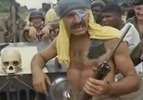 |
You and me both General Christmas said it best during the battle for Hue City: 
One thing I noticed when that MEU hit Kabul was that they all had suppressors. I knew they were going fleet wide but they really got them out there fast. | |||
|
| Member |
I was talking to a kid that graduated HS w/ my son 2 years ago. He is in the Marine Reserves. He is has a diesel mechanic MOS. He wanted to work on armor but, now working on trucks. Evidentially they got rid of that MOS and are getting rid of a bunch of MOS’s. He stated that the Corps is trimming down and going back to its infantry roots. I asked him who will work on their tanks until all the Marines w/ that MOS are gone and before the armor is all gone. He said the Army. I told him you better play nice w/ the Army then… | |||
|
Glorious SPAM! |
Unfortunately most all of the USMC tanks are already gone. The last few reserve units got rid of their tanks last summer. They have all been turned over to the Army and are sitting at the Sierra Army Depot in California. The only ones that are left are on MPF ships and as those ships rotate into port in the next few years they will be off loaded and shipped to SIAD. Some of the kids I knew who wanted to stay in were allowed to lat move to LAV or AAV or wherever there were boat spaces. Those that wanted to stay with tanks could do an inter-service transfer to the Army. Lots of the reservists joined Army National Guard units that had tanks if they wanted to stay tank. After the last tanks left Lejeune back in summer of 2020 I took a pic of the old tank ramp there. The only tanks left were an old M60A1 that had been at the CP and an old M103. Not sure where they are now. 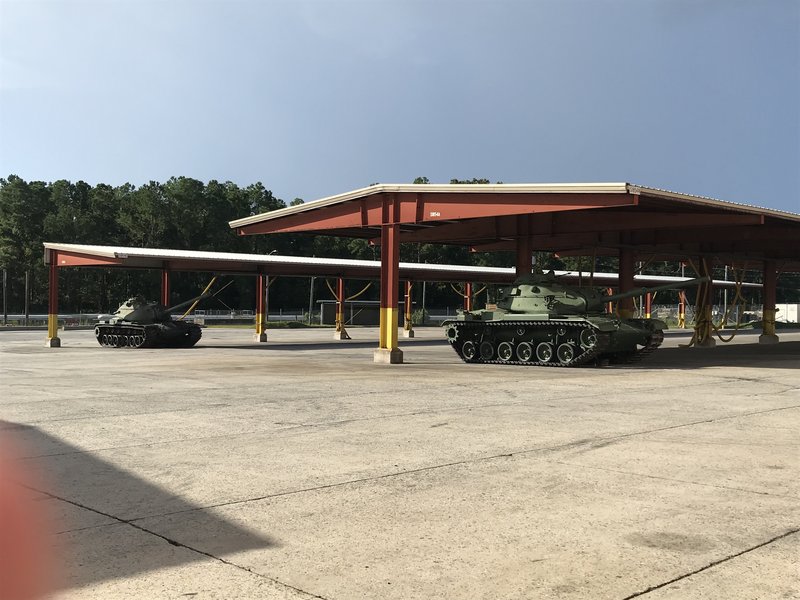 These pics were taken by combat camera ("You think you're Mickey Spillane? You think you're some kind of a fuckin' writer?") when the last tanks rolled from the tank ramp to the rail head. Good stuff.  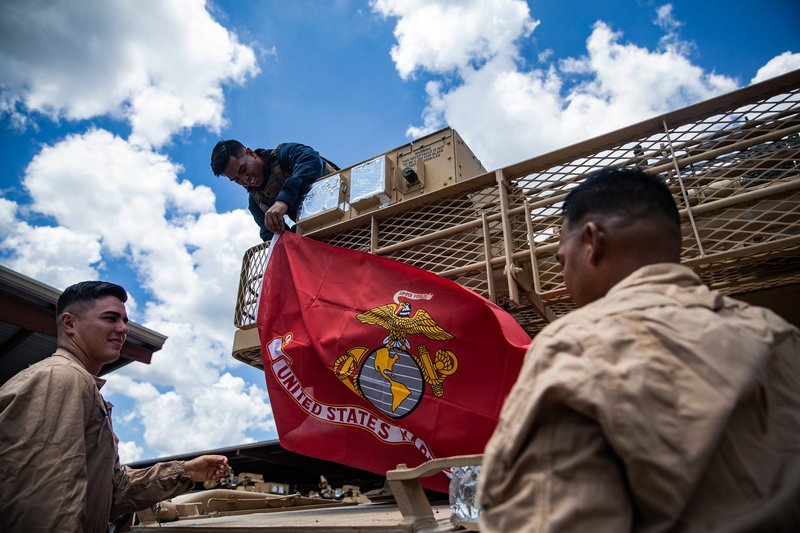 A few weeks after the tanks rolled out the last of the M88’s left. As much as I love tanks as a mech the M88 was my baby. I don’t do social media but my buddy sent me this pic. Not sure where he got it. 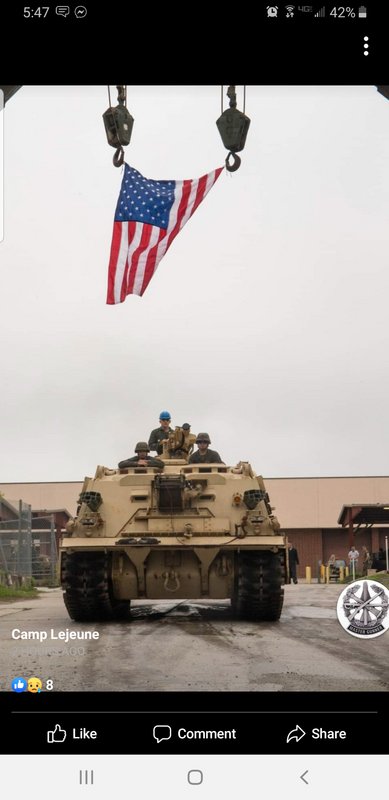 I zoomed in and sent this back to him lol. 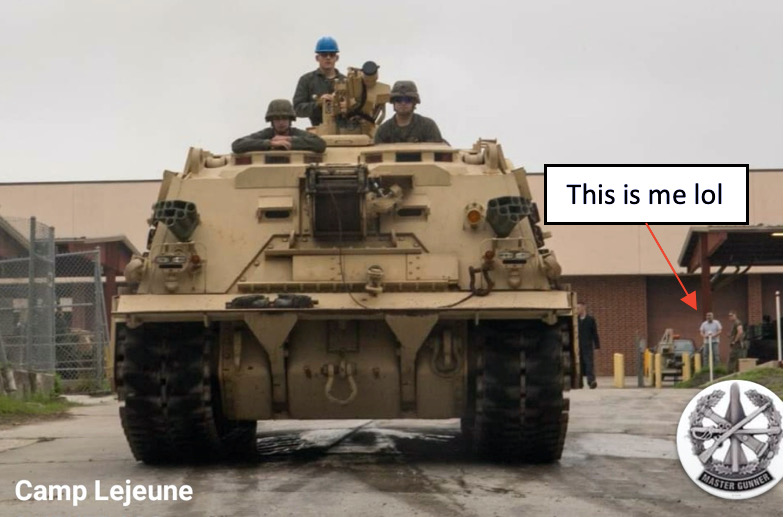 The current Commandant does indeed want to lighten up the Corps but I believe, as many others do, it won't turn out well. Too focused on one theater, the South China Sea. When war breaks out in Europe congress won't care what you are set up for they are just going to tell you to go. And Europe is tank country. Gen Berger says they can just "borrow" tanks from the Army if the need them. The last Army Lt Col I mentioned that too just laughed at me. I don't blame him, I laughed too. But enough of that, I am glad they are able to field new equipment so fast. M27's, suppressors, the new 40mm launcher, hell even the new Magpul mags. The last Commandant that really wanted to upgrade the individual gear was Gen Krulak and that was more just getting rid of the old 782 gear, Alice packs, shelter halfs, etc. And that seemed to take longer than getting these new weapons issued. | |||
|
Glorious SPAM! |
Old pic. In my USMC youth. You got tank questions, I'm your man. 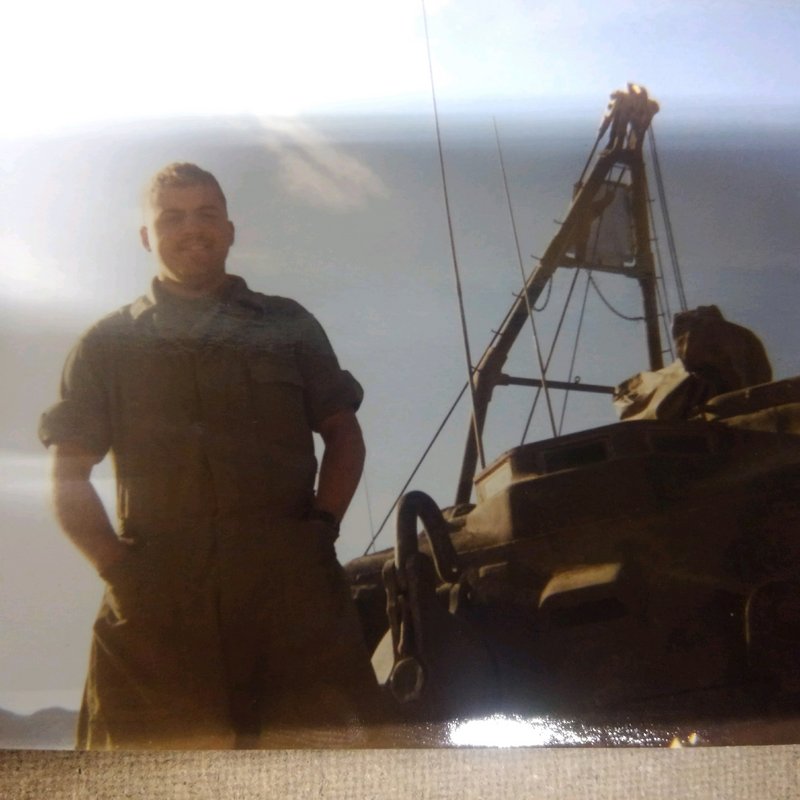 25 years later I would be loading USMC tanks on Air Force C17's in Trashcanistan. 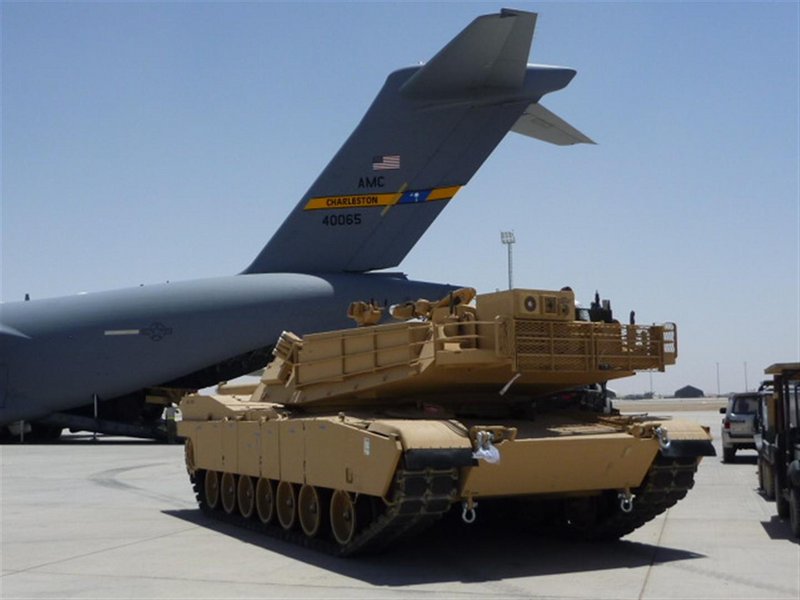 Semper Fi my brothers. | |||
|
| Member |
I guess the red dot mounted on the main optic is a good idea. But I wonder how easily damaged it would be under actual combat. End of Earth: 2 Miles Upper Peninsula: 4 Miles | |||
|
| Member |
I signed up "Delayed Entry" in 1980. Wanted Armor. I was in boot camp 2 weeks after high school. Right before graduation the D.I. informs you what MOS your have. The wind was knocked out of me when he said I was an 0311 (Infantry). I found out later on in Infantry school I lost armor because I didn't pass my swim qual. (I know, I can't swim well/Marine logic). Anyway, I grew to love the infantry. (actually got picked for 8541, scout/snipers after my second year) That being said, I think giving up tanks is a bad idea for the Corps. As an Infantryman, having a mobile pill box handy to break through certain obstacles instead of wasting men trying to take the position is a Godsend. I understand their theory but I think it's flawed. Maybe trim the ranks some. Maybe less tanks & more AFV but that big 120mm & armored box is a nice asset to have. At least from a leg infantry view. Rom 13:4 If you do evil, be afraid. For he does not bear the sword in vain. For he is God's minister, an avenger to execute wrath on him who practices evil. | |||
|
| Member |
This move away from Tanks is a smart move. The USMC is forever fighting the battle of "why do you exist?" The army can do everything you can do. The navy historically fought to have a dedicated infantry unit for things such as installation security and projection of forces ashore from Navy ships. How do you get a tank to go ashore from the gators or helicopters/V-22s? If you are going somewhere with enough port facilities built to bring in a RO/RO ship or land a C5, you can send in an Army tank unit. The Marines need to be different enough in capability and focus to keep them from just being another Ranger Battalion. | |||
|
| Member |
The link has several photos. https://www.usni.org/magazines...ember/tanks-no-tanks Tanks, But No Tanks By Lieutenant Commander Larry Parker, U.S. Navy (Retired) November 2021 Proceedings Vol 147/11/1,425 The remarkable U.S. victory at Midway in June 1942 and the brutal battle for Guadalcanal from August 1942 to February 1943 radically altered the balance of power in the Pacific. As a result of these events, Japan adopted a strategically defensive/tactically offensive policy, seeking an opportunity to regain the initiative. The United States, on the other hand, sought to capitalize on the dramatic reversal of fortune, allowing the enemy no respite. With this in mind, in return for U.S. support of allied operations in the Mediterranean, Admiral Ernest King and General George Marshall secured additional resources for the Pacific theater from the Combined Chiefs at the Casablanca Conference in January 1943. By late summer, general intentions had become specific objectives, and, at the Quebec Conference in August 1943, the Allied high command committed to a dual offensive against Japan. This two-pronged advance called for Australian and New Zealand Army Corps (ANZAC) forces in the southwest Pacific under the overall command of General Douglas MacArthur to advance on the New Guinea-Mindanao axis toward the Philippines, while Admiral Chester Nimitz gathered a mighty armada in the central Pacific and charted a course through the Gilberts, Marshalls, and Marianas. Thousands of man-hours were spent in planning and preparation taking into account every factor—except Japanese ingenuity and tenacity. For the Navy and Marine Corps, the first step on the road to Japan was Tarawa. Operation Galvanic began with a week of intensive bombing by B-24s under the operational control of Admiral John H. Hooper. This was followed by air raids from the fast carriers of Task Force 58 prior to D-Day. On 18 November, carrier-based planes dropped 115 tons of bombs on the hapless islet. They struck again on 19 November with an additional 69 tons of ordnance plus 250 tons of high explosives from Cruiser Division 56. On the morning of 20 November, three old battleships and five heavy cruisers of Rear Admiral Harry Hill’s bombardment group began the real show. Over the next four hours 3,000 tons of projectiles slammed into Betio. The entire island disappeared in flames and smoke. Barracks were destroyed, an ammunition dump was hit with spectacular results, and many enemy coastal defense guns were knocked out. Rear Admiral Howard F. Kingman boasted, “Gentlemen, we will not neutralize Betio. We will not destroy it. We will obliterate it.”1 Embarked Marines were elated. Unfortunately, their excitement was unfounded. In preparation for the inevitable American attack, the Japanese had dug gun emplacements, mortar and machine gun pits, and bomb shelters and constructed reinforced concrete command centers. Many of these were roofed with tough green coconut tree logs and covered with sand to absorb shellfire. Most of the Japanese weathered the storm of steel in these secure bombproof dugouts. Instead of conducting a mopping-up operation, the 2d Marine Division suffered 1,115 killed and 2,292 wounded, the highest casualty rate of any Marine unit during World War II (30 percent the first day, 17 percent overall). Of the 4,836 defenders, only 17 Japanese soldiers and 129 Korean laborers survived. That tragic story was repeated in the Marianas and the Volcano Islands. Despite the tons of bombs that rained down on Saipan and the 2,400 14- and 16-inch shells hurled at it, the preliminary bombardment had little impact on its natural and man-made defenses. After 26 days of close-quarters combat, Saipan was secured, but at a cost of 3,400 killed and 13,100 wounded. In the case of Iwo Jima, the Imperial Japanese Army began intense defensive preparations nearly a year prior to the invasion on 19 February 1945, creating a dense network of mutually supporting machine gun, mortar, and artillery bunkers with overlapping fields of fire connected by 11 miles of tunnels. To reach these strong points, the invaders first had to traverse carefully laid minefields. Storage facilities for food, water, and ammunition, medical facilities, mess halls, barracks, and command centers as much as 90 feet underground were carved out of the volcanic rock. Generators provided light and power for communication equipment. Consequently, the aerial and naval bombardment that began on 15 June 1944 had little effect. With Japanese defenses more or less intact and little room to maneuver, the battle became a bloody, brutal slugfest. When Iwo Jima fell on 26 March 1945, for the first and only time during the Pacific war, U.S. casualties (dead and wounded) exceeded those of Japan. The solution to the problem of a fanatical and resourceful enemy and ineffective aerial and naval bombardment was tanks. Initially, M3 Stuart and M4 Sherman tanks were used as direct-fire bunker busters and/or to provide covering fire so that sappers could get close enough to place their charges on Japanese strong points. In addition, improvised field modifications to some Sherman tanks gave them a limited flame-throwing capability. These measures proved so effective that Navy SeaBees began installing the Mark-1 flamethrower in the M4A3 Sherman. This modification gave the Sherman the ability to shoot a stream of napalm 150 yards through the 75-mm main gun. Without this valuable tool, the butcher’s bill at Iwo Jima would have been far worse. Tanks also served Marines well in the Korean War, when hordes of T-34s swarmed over the 38th parallel, and again in retaking Hue City after the 1968 North Vietnamese Tet Offensive. Despite this storied service, the Marine Corps has decided to divest itself of heavy armor and return to its “maritime roots” as light naval infantry. Contingent to this plan is an understanding that the Army will provide heavy armor if and when tanks are needed—all well and good if the Army has armor available and if the inevitable interservice communication problems and operational differences can be resolved in the heat of battle. No doubt budget constraints are involved in this decision, as tanks are undeniably expensive to acquire and maintain. No doubt data was analyzed, assumptions made, and contingency plans drawn up. In the history of warfare, however, seldom do assumptions and plans correspond with reality. Battlefield experience indicates that sooner rather than later the Marine Corps will regret this decision. | |||
|
| Freethinker |
Who said, “Those who forget history are doomed to repeat it”? Or as someone else said, “It’s not history that repeats itself, but human nature.” It’s human nature to focus on the things we like, and ignore those we don’t. ► 6.0/94.0 To operate serious weapons in a serious manner. | |||
|
| Powered by Social Strata | Page 1 2 |
| Please Wait. Your request is being processed... |
|
SIGforum.com  Main Page
Main Page  Mason's Rifle Room
Mason's Rifle Room  "The Weaponry of the Future Marine Corps Rifle Squad" UPDATED Dec 9, 2021
"The Weaponry of the Future Marine Corps Rifle Squad" UPDATED Dec 9, 2021
 Main Page
Main Page  Mason's Rifle Room
Mason's Rifle Room  "The Weaponry of the Future Marine Corps Rifle Squad" UPDATED Dec 9, 2021
"The Weaponry of the Future Marine Corps Rifle Squad" UPDATED Dec 9, 2021© SIGforum 2025